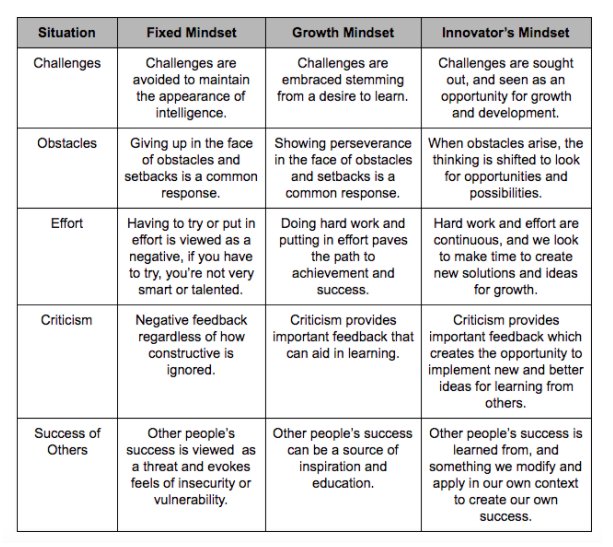This is an image I modified from the book, “The Growth Mindset Coach,” and then added my column for “The Innovator’s Mindset“:

As focusing on a “growth mindset” has become amazingly popular in schools, there have been several criticisms that the work is not beneficial, or sometimes misinterpreted. All fair criticisms of the work, even coming from Carol Dweck herself.
Although I truly believe that there is no “mindset” that applies to every situation; I have a very fixed mindset about skydiving. I also believe that the notion of not having a growth mindset has been used to label people that don’t agree with a certain direction of an organization or school. Many people challenge, not to hold on, but to move forward.
But with any idea, there are interpretations and modifications that are made to apply to the context people are working within. There is no idea that can be simply carbon copied to work with students. People use Hattie’s work all of the time, but the factors that are deemed to “work” do not necessarily work with all students in all situations. We have to remember that people are always a variable, and we have to realize that people have different experiences, as well as wants and needs for their own personal growth. I recently read a quote (paraphrasing) that research should be used to influence practice, not determine the exact path. This combines both the “science” and “art” of teaching.
I do this activity after I do a keynote where I have people write down, what they hope to get out of the day, and what they would like to learn moving forward. Even though the same keynote is shared with everyone, the answers from individuals vary greatly, and then I reshape the day on what the learners need, not on what I want to teach them.
With all this being said, this is why I have been focusing on helping people develop an “innovator’s mindset” in their work. As defined in my work:

Similar to the idea of not having a growth mindset in all situations, this mindset does not apply to anything and everything. It is also meant to be an extension of the concept of the “growth mindset,” not a competing idea. The simplest way I explain this to people is that I do not want our students to only “learn” math, but to be able to do something with the math they have learned. This quote from Thomas Friedman really makes sense to me:

But this cannot be reserved for only students, but something we develop in adults as well. I want to be a person that creates opportunities for myself and for those that I serve based on what I know.
Too often though, people connect the word “innovation” to “entrepreneurship,” but it can be applied to any position and any role. My first assistant principal exemplified this mindset in spades, as not only was she amazingly knowledgeable, she would continuously create opportunities for students and staff without waiting for any direction from myself as the principal. I cannot remember asking her to do one thing in my role as principal, because she was always so far ahead creating so many incredible opportunities for others. So many educators do the same within the constraints of doing their job, balancing doing what they have to do, while ensuring they find a way to do what is important. That is the “Innovator’s Mindset” exemplified.
Something I believe:

Again, there are some spaces when change is thrust upon me, and sometimes when I create it for myself. It is not an “all or nothing” scenario. But, as we look to the future of schools, I hope that we focus on how to empower our students to find and create their pathways, by modeling the same mindset ourselves.